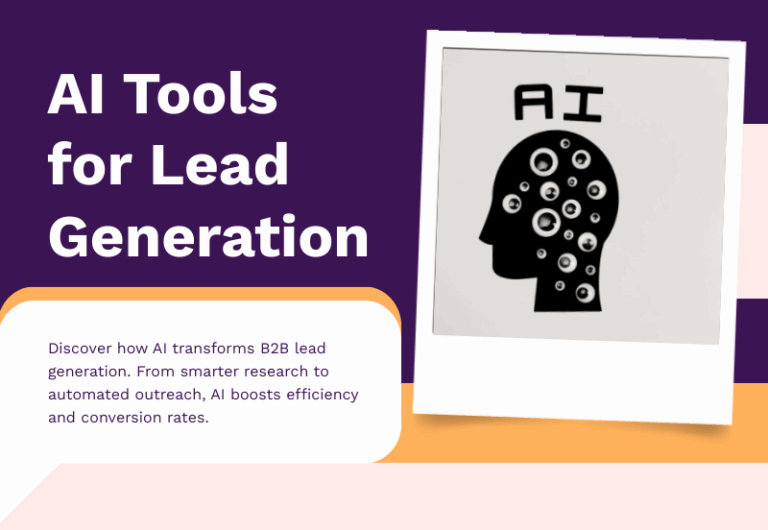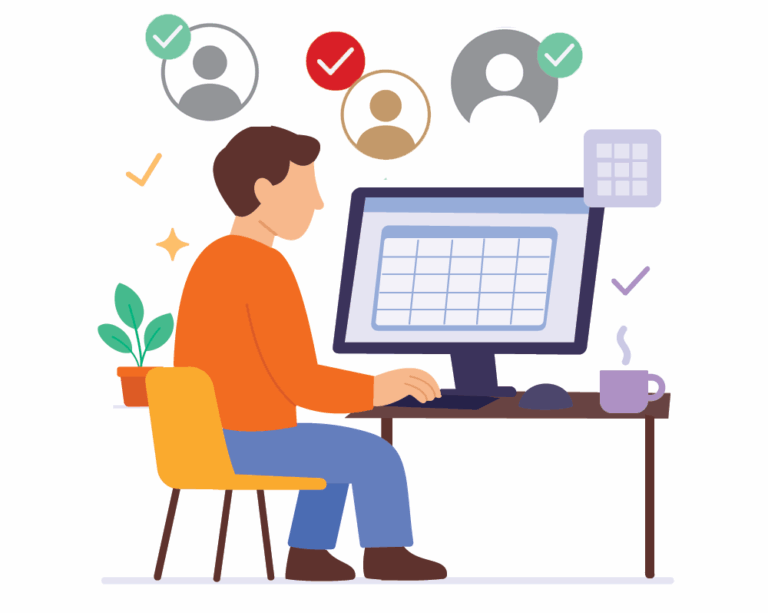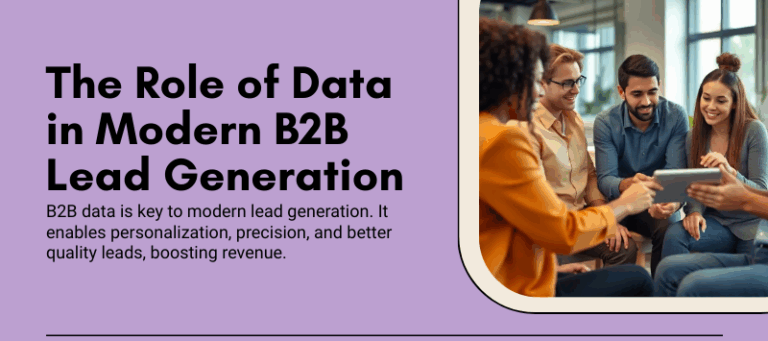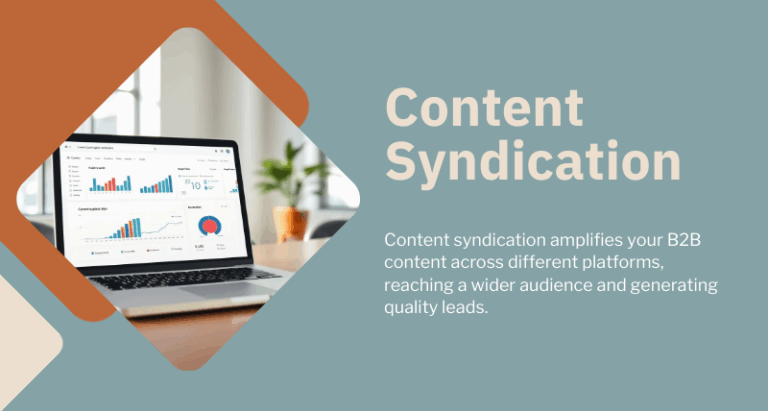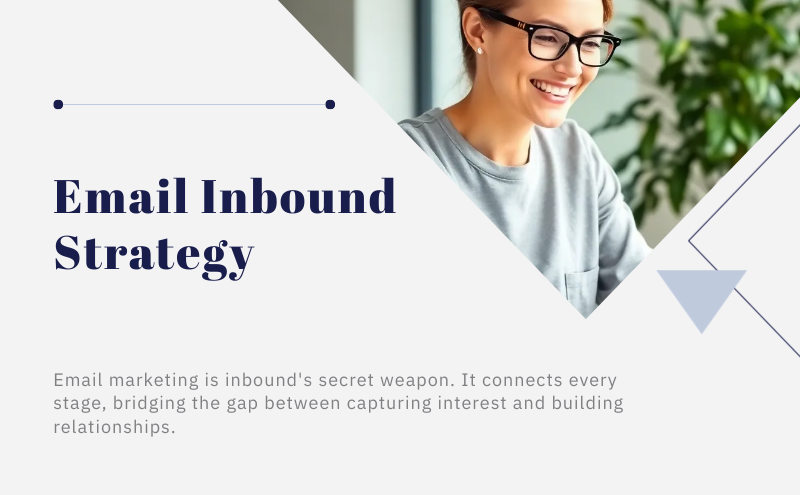
Inbound marketing is all about attracting, engaging, and delighting customers through valuable, relevant content. While many think of inbound as blogs, SEO, and social media, there’s one channel that amplifies every other effort: email marketing.
Email doesn’t just distribute content — it connects every stage of the inbound funnel. Done right, it bridges the gap between capturing interest and driving long-term customer relationships.
So, how can email marketing fuel your inbound strategy? Let’s break it down step by step.
Why Email Marketing Is Inbound’s Secret Weapon
- Direct Access to Audiences: Unlike social media, where algorithms filter reach, email lands directly in inboxes.
- Personalization at Scale: Segmentation and automation allow you to deliver the right content to the right person at the right time.
- Proven ROI: According to industry benchmarks, email generates an average return of $36 for every $1 spent — among the highest of any marketing channel.
- Lifecycle Versatility: Email works for awareness, consideration, and decision-making, making it the most versatile inbound tool.
The Inbound Funnel and Email Marketing’s Role
1. Attract
Inbound begins by drawing prospects in with content, SEO, and social promotion. Email isn’t typically the first step here, but it plays a key supporting role.
- Content Distribution: Use newsletters to push out blogs, eBooks, and webinars.
- Referral Loops: Encourage subscribers to forward or share content, extending reach organically.
- Lead Magnets: Promote downloadable assets in exchange for email addresses, building your inbound list.
2. Engage
This is where email marketing shines — nurturing leads into qualified opportunities.
- Segmented Nurture Campaigns: Deliver relevant content based on persona, behavior, or funnel stage.
- Triggered Workflows: Automate responses to actions (e.g., clicking a pricing page link).
- Educational Drips: Guide subscribers through awareness into consideration with structured sequences.
3. Delight
Inbound doesn’t stop after a sale. Email continues to fuel the flywheel by creating loyal advocates.
- Onboarding Campaigns: Help new customers adopt your product faster.
- Customer Success Content: Share tips, best practices, and advanced strategies.
- Feedback & Reviews: Use post-purchase emails to collect testimonials and fuel social proof.
Key takeaway: Email is the connective tissue of inbound. It ensures no stage of the funnel operates in isolation.
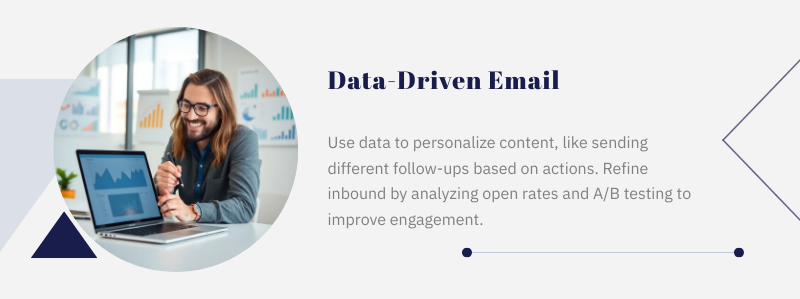
Data-Driven Email: Turning Insights into Engagement
Personalization Beyond First Names
Today’s buyers expect more than “Hi [First Name].” They want content tailored to their needs.
- Behavior-Based Targeting: Send different follow-ups to someone who downloaded a whitepaper versus someone who requested a demo.
- Dynamic Content Blocks: Show different images, CTAs, or offers depending on customer segment.
Using Analytics to Refine Inbound
- Open & Click Data: Reveals what content resonates most.
- Heatmaps: Show how subscribers engage with layouts, informing design decisions.
- A/B Testing: Optimize subject lines, CTAs, and send times.
When you use email data to guide inbound, blog topics, webinars, and even product development become more aligned with real audience interest.
Email + Content Marketing: A Symbiotic Relationship
Email marketing is only as strong as the content behind it. Likewise, inbound content is far more effective with email distribution.
- Repurposing Blog Posts: Turn a blog series into a drip campaign.
- Promoting Long-Form Assets: eBooks and guides gain traction when pushed via segmented email lists.
- Highlighting Case Studies: Share success stories to build credibility deeper in the funnel.
Internal linking opportunity: From this section, link to your content marketing services page, positioning email as the delivery engine of inbound content.
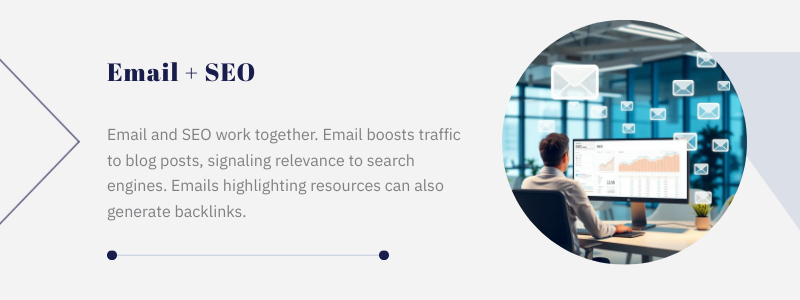
Email + SEO: Extending Organic Reach
Many executives don’t realize email and SEO reinforce each other.
- Traffic Boosts: Driving subscribers to blog posts increases page views and signals relevance to search engines.
- Backlink Potential: Emails that highlight high-value resources can lead to natural backlink growth when shared.
- Keyword Feedback: Analyzing email engagement helps identify which topics should be prioritized in your SEO strategy.
Email + Social Media: Multi-Channel Amplification
Email doesn’t compete with social — it amplifies it.
- Cross-Promotion: Encourage email subscribers to follow your social channels and vice versa.
- Exclusive Communities: Use email to invite subscribers to private groups or events.
- Social Proof in Email: Showcase user-generated content or reviews gathered from social platforms.
Practical example: A B2B company runs a LinkedIn webinar promotion. Pairing it with segmented email outreach doubles attendance rates compared to social-only campaigns.
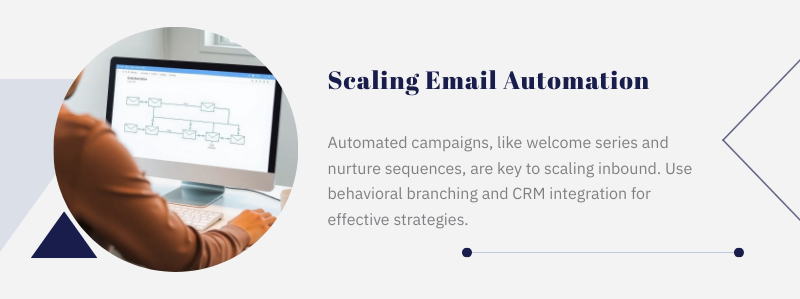
Automation: Scaling Inbound with Email
Without automation, email marketing is manual and limited. With it, inbound strategies become scalable.
Common Automated Campaigns
- Welcome Series: Sets tone and expectations when someone joins your list.
- Lead Nurture Sequences: Push prospects through funnel stages with timely, relevant content.
- Re-Engagement Campaigns: Win back inactive subscribers before they churn.
Advanced Tactics
- Behavioral Branching: Workflows that change based on subscriber actions.
- Scoring Models: Combine email engagement with inbound activities (downloads, page visits) to qualify leads.
- CRM Integration: Syncing with Salesforce, HubSpot, or other CRMs ensures marketing and sales alignment.
Compliance and Trust-Building
Inbound thrives on permission-based marketing. Email laws reinforce this principle.
- CAN-SPAM / GDPR / CASL: Ensure clear opt-ins and easy unsubscribe options.
- Preference Centers: Allow subscribers to customize the content they receive.
- Transparency: Communicate value upfront — why someone should subscribe and what they’ll get.
For decision-makers, compliance isn’t just about avoiding fines — it’s about building long-term trust that keeps the inbound flywheel spinning.
Practical Scenarios: Email in Action
SaaS Company
- Captures leads via a free trial sign-up.
- Automated nurture series educates users on key features.
- Upsell email at trial end boosts conversions.
B2B Professional Services Firm
- Publishes a whitepaper gated behind a form.
- Drip campaign nurtures readers with case studies and webinar invites.
- Direct sales outreach follows when engagement signals are strong.
eCommerce Brand
- Blog articles attract organic search traffic.
- Newsletter highlights product guides and seasonal content.
- Post-purchase emails cross-sell accessories, fueling repeat purchases.
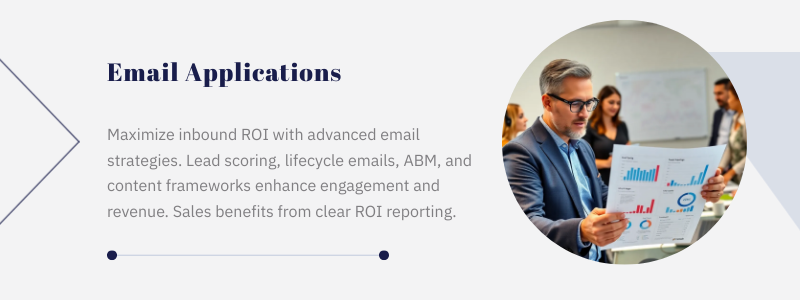
Applications of Email Marketing in Inbound Strategy
While basic campaigns like newsletters and lead nurturing are essential, organizations that want to truly maximize inbound ROI need to move beyond the fundamentals. Here’s how advanced email strategies can take your inbound program to the next level.
1. Lead Scoring and Email Synergy
Email engagement is one of the clearest indicators of buyer intent. By pairing email metrics with a lead scoring model, businesses can prioritize prospects more effectively.
- High-Value Triggers: Clicking on a pricing link or opening multiple case study emails within a short period.
- Moderate-Value Triggers: Engaging with blog content or attending a webinar promoted through email.
- Low-Value Triggers: Only opening newsletters without further interaction.
Why it matters: When sales teams focus on leads with high email engagement, the handoff from marketing to sales is smoother, reducing wasted outreach.
2. Lifecycle Email Campaigns
Inbound is not just about getting leads into the funnel — it’s about managing the entire customer lifecycle.
- Onboarding Series: Guides new customers through initial setup, reducing churn risk.
- Product Education Campaigns: Regularly highlight underused features to increase adoption.
- Renewal Reminders: Nudge customers as contracts or subscriptions approach expiration.
- Advocacy Programs: Encourage loyal customers to refer others or leave reviews.
Executive takeaway: Lifecycle emails transform inbound marketing from a lead-generation engine into a retention and expansion strategy.
3. Account-Based Marketing (ABM) with Email
For B2B organizations targeting high-value accounts, email can serve as the personalized touchpoint that aligns with ABM.
- Customized Campaigns: Build sequences specifically for each target account.
- Multi-Stakeholder Outreach: Send role-specific content (e.g., ROI calculators for CFOs, case studies for operations managers).
- Trigger-Based Engagement: Notify sales reps when target accounts interact with ABM emails.
ABM-driven email campaigns bridge marketing and sales, fueling inbound with highly personalized engagement.
4. Content Distribution Frameworks
A common inbound challenge is content underutilization. Many businesses invest heavily in creating blogs, videos, or whitepapers, but fail to maximize distribution.
Solution: Email Frameworks
- Launch Framework: Whenever a new piece of pillar content goes live, promote it via email with a clear CTA.
- Repurposing Framework: Break larger assets into email mini-series, extending content lifespan.
- Seasonal Framework: Align emails with industry events or seasonal trends to keep content timely.
Impact: This ensures every asset you create works harder, feeding inbound visibility across multiple touchpoints.
5. Integrating Email with CRM and Marketing Automation
When email is isolated, inbound campaigns lack cohesion. Integrated systems unlock full potential:
- CRM Data Sync: Updates contact records with email engagement for better sales context.
- Cross-Channel Automation: Combine email with SMS, retargeting ads, and chatbots.
- Revenue Attribution: Connect email engagement directly to pipeline and closed deals.
Executives benefit from clear ROI reporting, ensuring inbound isn’t just driving leads but measurable revenue.
The Psychology of Email in Inbound
Understanding why email works so well in inbound requires looking at the psychology of decision-making.
Reciprocity
Inbound thrives on value exchange. Emails that deliver educational resources build trust, prompting prospects to reciprocate with attention or purchase consideration.
Consistency
Subscribers who engage regularly with emails are more likely to maintain consistency in their behavior — eventually converting or upgrading.
Authority
Emails featuring thought leadership content position your brand as an industry authority, influencing decision-makers.
Scarcity & Urgency
Tactfully using time-sensitive offers or exclusive invites within inbound emails can accelerate funnel progression.
Measuring Success: Key Metrics for Inbound Email
To prove that email is fueling inbound, measurement is critical. Go beyond vanity metrics like open rates and focus on deeper indicators.
- Lead-to-MQL Conversion Rate: How many new leads convert into marketing-qualified leads through email nurturing.
- Content Engagement: Track which resources drive the most downstream activity.
- Sales Velocity Impact: Measure whether engaged email leads close faster.
- Revenue Contribution: Attribute deals to email campaigns using CRM tracking.
Executives should view email not just as a communication tool but as a revenue engine.
Checklist: Making Email Central to Inbound
Here’s a simple checklist to integrate email seamlessly:
- List Building: Are you capturing emails via forms, pop-ups, gated content, and webinars?
- Segmentation: Have you divided audiences by persona, funnel stage, or engagement level?
- Automation: Do you have workflows for nurturing, onboarding, and re-engagement?
- Content Calendar: Is email aligned with your blog, social, and SEO content schedule?
- Testing: Are you A/B testing subject lines, CTAs, and send times?
- Measurement: Can you attribute email engagement to pipeline and revenue outcomes?
Frequently Asked Questions: Email Marketing and Inbound Strategy
1. How does email marketing support inbound strategy?
Short Answer: Email marketing nurtures leads, distributes content, and builds lasting customer relationships — fueling every stage of the inbound funnel.
Expanded: Inbound attracts prospects through valuable content and SEO, but email ensures those leads don’t stall in the funnel. By delivering blogs, case studies, and resources directly to subscribers, email keeps audiences engaged. Automated nurture sequences guide prospects toward purchase decisions, while onboarding and loyalty campaigns extend lifetime value. Without email, inbound campaigns risk losing momentum after the initial attraction stage.
2. What types of email campaigns are most effective for inbound?
Short Answer: Welcome series, lead nurturing drips, newsletters, onboarding campaigns, and re-engagement sequences are most impactful.
Expanded:
- Welcome Series: Sets expectations and introduces brand value to new subscribers.
- Nurture Drips: Deliver targeted resources based on buyer persona or funnel stage.
- Newsletters: Keep audiences updated with fresh inbound content (blogs, webinars, guides).
- Onboarding Campaigns: Help customers adopt products/services quickly, reducing churn.
- Re-Engagement Emails: Target inactive subscribers to win back attention.
Together, these campaigns ensure inbound leads are continually moving toward conversion.
3. Can email marketing improve SEO performance?
Short Answer: Yes — indirectly, by boosting traffic, engagement, and backlink opportunities.
Expanded: Email drives qualified traffic to blog posts and landing pages, signaling relevance to search engines. When subscribers share content, it increases natural backlink potential. Engagement data from email (clicks and interests) also informs keyword strategy, ensuring SEO efforts align with real audience demand. While email itself isn’t a direct ranking factor, its role in amplifying SEO-driven content is undeniable.
4. How often should businesses send inbound marketing emails?
Short Answer: It depends on the audience, but consistency and value matter more than volume.
Expanded: Many companies find success with weekly or bi-weekly newsletters, supported by automated campaigns triggered by behavior. Sending too frequently can lead to unsubscribes, but sending too infrequently risks brand forgetfulness. The right cadence balances predictability with relevance — every email should serve a clear purpose, whether it’s educating, nurturing, or delighting the subscriber.
5. What role does personalization play in inbound email marketing?
Short Answer: Personalization ensures relevance, which drives higher engagement and conversion.
Expanded: Modern email personalization goes beyond first names. It includes segmenting based on buyer persona, industry, funnel stage, and behavior. For example, a subscriber who downloads a pricing guide should receive different follow-ups than one who reads a blog. Personalization also extends to dynamic content blocks, where different subscribers see different CTAs or offers in the same email. For inbound to succeed, personalization is essential.
6. How do you measure the success of inbound email campaigns?
Short Answer: Measure conversions, engagement, and revenue contribution — not just opens and clicks.
Expanded:
- Lead Conversion Rate: Percentage of new leads that become marketing-qualified leads through email.
- Content Engagement: Which resources receive the most clicks and downstream activity.
- Sales Velocity Impact: Whether email-engaged leads move through the funnel faster.
- Revenue Attribution: Tying closed deals back to email campaigns in your CRM.
Executives should view email reporting not as vanity metrics but as pipeline and revenue metrics.
7. How does email integrate with other inbound channels?
Short Answer: Email amplifies SEO, content, and social — making inbound efforts more effective.
Expanded:
- SEO: Emails drive traffic to blog content, signaling relevance.
- Content Marketing: Newsletters and nurture campaigns extend content reach.
- Social Media: Email can promote exclusive communities, events, or campaigns.
By serving as the distribution hub, email ensures all inbound efforts are connected, not siloed.
8. Should B2B and B2C businesses approach inbound email differently?
Short Answer: Yes, though principles overlap, execution differs.
Expanded:
- B2B Email Marketing: Focuses on education, case studies, webinars, and long nurture cycles. Personalization by role (CFO vs. Operations Manager) is critical.
- B2C Email Marketing: Often emphasizes promotions, lifestyle content, and shorter buying cycles. Automation and segmentation by purchase history play a bigger role.
Both models rely on trust-building and delivering value first, but cadence, messaging, and design differ.
9. What compliance issues should businesses consider?
Short Answer: Respect privacy laws like GDPR, CAN-SPAM, and CASL with clear opt-ins and unsubscribes.
Expanded: Compliance isn’t just about legal protection; it reinforces inbound’s core principle — permission-based marketing. Companies should:
- Use double opt-in for subscribers.
- Provide easy unsubscribe options.
- Offer preference centers so recipients control frequency and topics.
Being transparent strengthens trust, turning compliance into a competitive advantage.
10. Is email marketing still effective in 2025 and beyond?
Short Answer: Absolutely — it remains one of the highest ROI inbound channels.
Expanded: Despite the rise of AI, chatbots, and social algorithms, email continues to deliver unmatched ROI ($36 per $1 spent on average). Its direct, owned nature means businesses control reach — not third-party platforms. With advances in AI personalization, predictive analytics, and interactive email formats, the channel is only becoming more powerful. For inbound marketers, email remains essential.
